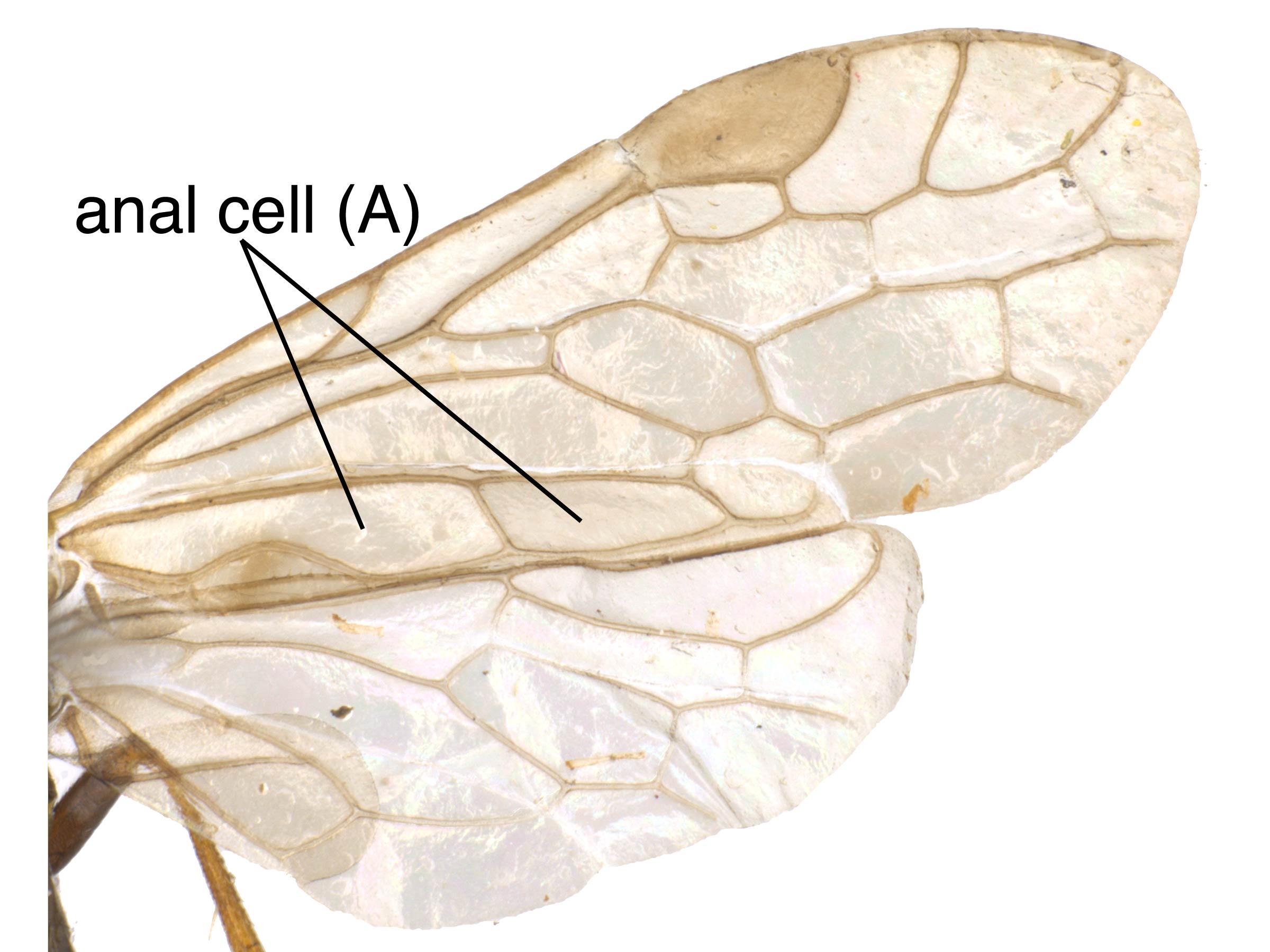Family: Tenthredinidae
Family common name: common sawflies
Subfamily: Heterarthrinae
Tribe: Fenusini
Genus: Prolatus D.R. Smith, 1967
Subgenera: none
The Tenthredinidae are the most species-rich family and are found throughout the world, in all continents but Antarctica. They are known as the “common sawflies.” They can generally be recognized by a cylindrical body and long, segmented antennaeantenna:
the sensory organ emerging from the front of the head, usually between the compound eyes and above the clypeus; includes the flagellum, scape and pedicel
 . Otherwise, they come in a variety of colors, sizes, and forms (Goulet 1992Goulet 1992:
. Otherwise, they come in a variety of colors, sizes, and forms (Goulet 1992Goulet 1992:
Goulet H. 1992. The genera and subgenera of the sawflies of Canada and Alaska: Hymenoptera. Symphyta. The insects and arachnids of Canada. Part 20. Agriculture Canada Publication.).
Sawflies in the Heterarthrinae subfamily are generally small and dark-colored. Many species of this family are economic pests of trees and shrubs and can be characterized by their skeletonizing or leaf-mining larval feeding behaviors. Heterarthrinae adults can be distinguished from those of other subfamilies by wing venationvenation:
the network of veins on a wing
(Smith 1971aSmith 1971a:
Smith DR. 1971a. Nearctic Sawflies. III. Heterarthrinae: Adults and larvae (Hymenoptera: Tenthredinidae). Technical Bulletin, U.S. Department of Agriculture 1420: 1-84.).
Prolatus is monotypicmonotypic:
describes having only one representative; ex. a genus that includes only one species
(Taeger et al. 2010Taeger et al. 2010:
Taeger A, Blank SM, and Liston AD. 2010. World Catalog of Symphyta (Hymenoptera). Zootaxa 2580: 1-1064.). Prolatus artus females are very small, about 3.8 mm in length, and entirely black with minute white hairs evenly distributed along the body. The male for this species is not known (Smith 1967cSmith 1967c:
Smith DR. 1967c. A review of the subfamily Heterarthrinae in North America (Hymenoptera: Tenthredinidae). Proceedings of the Entomological Society of Washington 69: 277-284.).
There is a single described extantextant:
in existence; opposite of extinct
species worldwide, and it occurs in North America (Taeger et al. 2010Taeger et al. 2010:
Taeger A, Blank SM, and Liston AD. 2010. World Catalog of Symphyta (Hymenoptera). Zootaxa 2580: 1-1064.).
Subfamily characters
 M slightly constricted at apexapex:
M slightly constricted at apexapex: vein 2r present (Goulet 1992Goulet 1992:
vein 2r present (Goulet 1992Goulet 1992:Genus characters
 veins 2A and 3A curved upwards and meeting 1A (Smith 1967cSmith 1967c:
veins 2A and 3A curved upwards and meeting 1A (Smith 1967cSmith 1967c: cellcell:
cellcell: R1 open to margin (Smith 1967cSmith 1967c:
R1 open to margin (Smith 1967cSmith 1967c: anal cellanal cell:
anal cellanal cell: absent (Smith 1967cSmith 1967c:
absent (Smith 1967cSmith 1967c: at least 1.5X the length of the fore and mid tibiatibia:
at least 1.5X the length of the fore and mid tibiatibia: , respectively (Smith 1967cSmith 1967c:
, respectively (Smith 1967cSmith 1967c: without basalbasal:
without basalbasal: simple (Smith 1971aSmith 1971a:
simple (Smith 1971aSmith 1971a:Prolatus can be confused with other genera in the subfamily, especially similar genus Fenusa. It can be distinguished by the lack of tarsal clawtarsal claw:
sharpened appendage emerging from the apex of the tarsus
 basalbasal:
basalbasal:
towards the base; closest to the body
lobe, long fore tarsusfore tarsus:
the tarsus of the fore leg
 , and long, slender antennaeantenna:
, and long, slender antennaeantenna:
the sensory organ emerging from the front of the head, usually between the compound eyes and above the clypeus; includes the flagellum, scape and pedicel
 (Smith 1967cSmith 1967c:
(Smith 1967cSmith 1967c:
Smith DR. 1967c. A review of the subfamily Heterarthrinae in North America (Hymenoptera: Tenthredinidae). Proceedings of the Entomological Society of Washington 69: 277-284.).
none
The only confirmed host of P. artus is Dichelostemma capitatum (bluedicks). This is the only known monocot host of a Fenusini leaf-mining sawfly (Eiseman and Smith 2019Eiseman and Smith 2019:
Eiseman CS and Smith DR. 2019. Prolatus artus Smith (Hymenoptera: Tenthredinidae), a leafminer of Dichelostemma capitatum (Benth.) Alph. Wood (Asparagaceae). Proceedings of the Entomological Society of Washington 121 (1): 115-118. https://doi.org/10.4289/0013-8797.121.1.115).
The complete biology of P. artus is unknown. LarvaeLarva:
the immature stage of holometabolous insects
 move from leaf apexapex:
move from leaf apexapex:
the end or most distal area of any structure
towards the basebase:
the beginning or most proximal area of any structure
, eating all the inner leaf tissue and leaving a trail of frassfrass:
solid larval excrement
. At maturity, the prepupae fall to the soil to burrow and pupate or possibly overwinter (Eiseman and Smith 2019Eiseman and Smith 2019:
Eiseman CS and Smith DR. 2019. Prolatus artus Smith (Hymenoptera: Tenthredinidae), a leafminer of Dichelostemma capitatum (Benth.) Alph. Wood (Asparagaceae). Proceedings of the Entomological Society of Washington 121 (1): 115-118. https://doi.org/10.4289/0013-8797.121.1.115).
World: This genus is known only from North America (Taeger et al. 2010Taeger et al. 2010:
Taeger A, Blank SM, and Liston AD. 2010. World Catalog of Symphyta (Hymenoptera). Zootaxa 2580: 1-1064.)
North America: Prolatus artus occurs in Oregon and Arizona (Smith 1967cSmith 1967c:
Smith DR. 1967c. A review of the subfamily Heterarthrinae in North America (Hymenoptera: Tenthredinidae). Proceedings of the Entomological Society of Washington 69: 277-284., Eiseman and Smith 2019Eiseman and Smith 2019:
Eiseman CS and Smith DR. 2019. Prolatus artus Smith (Hymenoptera: Tenthredinidae), a leafminer of Dichelostemma capitatum (Benth.) Alph. Wood (Asparagaceae). Proceedings of the Entomological Society of Washington 121 (1): 115-118. https://doi.org/10.4289/0013-8797.121.1.115).
Map data from: GBIF.org (29 October 2019) GBIF Occurrence Download Prolatus and the Smithsonian National Museum of Natural History Entomology Collection (USNM)
Details about data used for maps can be found here.